Sweet pepper, which we are accustomed to grow in the plots as an annual one, in our homeland - in Central America - is a thermophilic perennial plant with a long growing season. In our climatic conditions, he begins his life indoors long before the end of the frost - after all, without preliminary germination of seeds he will not be able to grow in the ground for such a short summer.
In large farms pepper for seedlings grown in greenhouses, but it is quite possible to grow it at home on the windowsill, and even an inexperienced gardener can plant seeds correctly, you just have to follow simple rules. In this case, the result will not be inferior to greenhouse specimens, and costs will decrease. To obtain a good harvest, you should pay attention to the preparation of seed material, as well as to ensure the plant's needs for a comfortable temperature, lighting, nutrition and moisturizing.
Content
Dates of planting pepper on seedlings for growing on the windowsill
The time for sowing pepper for home seedlings depends on several criteria, first of all, on the variety and own conditions in the house. The following parameters affect the landing dates:
- The growing season, or, in other words, is the ripening period, which ranges from 100 to 150 or more days, depending on the variety. Therefore, early varieties can be sown later.
- Conditions: the presence of a greenhouse, veranda, wide windowsill. It is also important what kind of lighting and temperature. If you have spacious areas, you can hold the seedlings of the house for longer, but crowding and poor light, on the contrary, indicate a shorter time spent in the room.
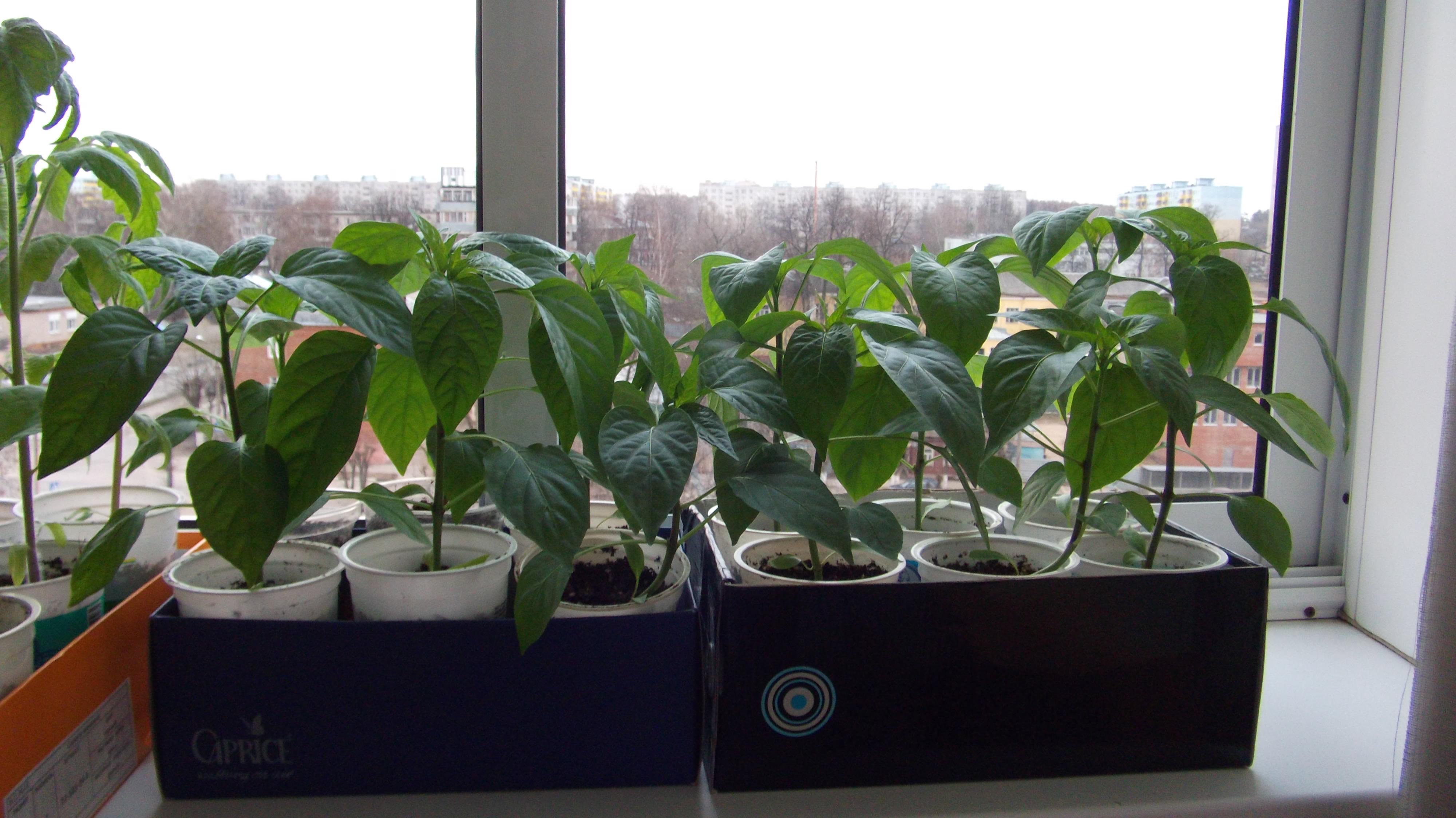
Since transplanting to the beds is in any case dictated by the climate, the reduction of the seedling period is a delay in the sowing period. - Estimated time of planting grown seedlings on the street. It is important where pepper will grow later. It can be planted in the greenhouse even in April, therefore, it is necessary to sow it earlier - in February. But heat-loving peppers move to the beds at the beginning of summer, so there is plenty of seedling time for it, you can sow in March.
- Has seed preparation been sown? The fact is that the seed must "wake up", feeling moisture and heat, and this also takes time.
In addition to these calculations, summer residents often use the lunar calendar, which indicates favorable seeding days. They are compiled by long-term observations of how each phase of the moon affects different processes: seed hardening, seedling growth, fruiting.
How to plant pepper seeds at home for seedlings
So, the timing of sowing is determined, a start has been made. Now is the time to deal with seeds and soil, without proper preparation it is impossible to expect a good result when growing pepper.
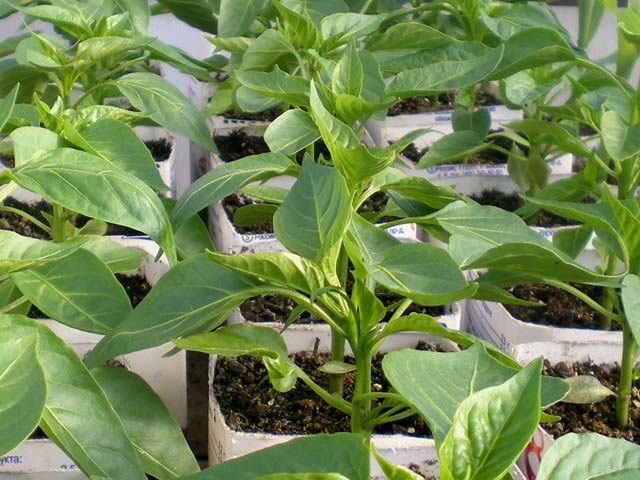 You may be interested in:
You may be interested in:Soil preparation
The soil mixture in which the seedlings will grow affects them most directly, as it serves as a source of nutrition. Soil requirements for pepper seedlings are as follows:
- neutral acidity with a pH of 6-6.5;
- high nutrition and safety, that is, it should not contain pathogens and pests;
- friability and ability to retain moisture.
For the sake of convenience and time saving, such land can be purchased at a garden store, but it is not difficult to make it yourself at home. The composition includes land from the garden, peat, humus, sand, sawdust of deciduous trees.
This will allow you to play it safe from possible pests and diseases of this family. For moisture balance, there is volcanic rock - agroperlite, which absorbs water, so it is worth adding to the mixture. Vermiculite is another important soil ingredient for seedlings, it will provide oxygen to future plants.
To destroy the pathogenic flora, the prepared soil must be calcined in the oven for an hour. Moreover, it is advisable to do this even for purchased land. Then, to restore nutrition, fertilizer should be added. Preparations based on the products of the vital activity of earthworms have proven themselves well in this role.
Seed preparation
Seeds are best to buy trusted brands, professional. Collected with your own hands also give a good harvest, provided that they are not taken from a hybrid. Their preparation consists of 4 stages:
- Sorting. This is a mechanical selection of high-quality seeds, throwing out deformed, empty, damaged.
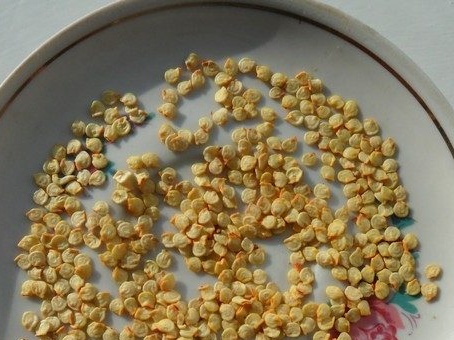
Seed selection - Disinfection. Fungi spores and other pathogens can be found on the seeds, so you need to soak them in a preparation that can neutralize the pathogenic flora. Most often they use potassium permanganate, Fitosporin, Mikosan. Duration of soaking (also called pickling) - 30 minutes. Then rinse in clean cold water.
- Growth stimulation. There are substances that activate germination. It can be ready-made drugs: Epin, Zircon, HB-101. From home remedies apply a solution of honey, infusion of willow twigs. It is necessary to soak clean seeds for 12 hours - a day.
- Germination. This procedure usually lasts 5-10 days and consists in keeping the seeds in a damp cloth, which prevents them from drying out.
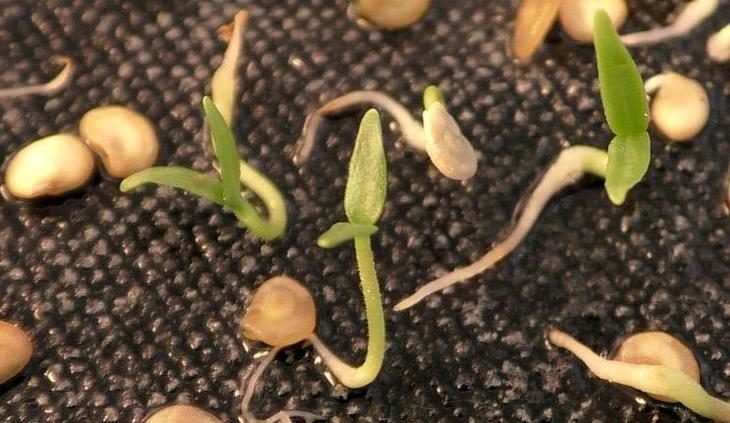
Seed germination
Usually, more than one variety of peppers is grown, so for each you need to take a separate container in order to carry out all of the above procedures and not mix the varieties. Sprouted seeds should be handled with extreme care, as the prolate roots are very fragile.
Seed sowing technology
Sowing is carried out both in separate containers and in general boxes. Their difference is that in the second method, shoots will then be picked. Before use, the trays must be rinsed with a potassium permanganate solution for disinfection.
At the bottom of the selected dishes, it is necessary to lay a drain to ensure that excess water is drained and out through the holes - young seedlings are very afraid of waterlogging. Pour the soil almost to the top from above. Tamp lightly, but without effort, so that the earth is loose, with sufficient air gaps. In such soil, thin roots are easier to grow deeper and develop, consuming oxygen.
Now the jewelery work begins: hatching seeds need to be laid out on the surface of the soil.
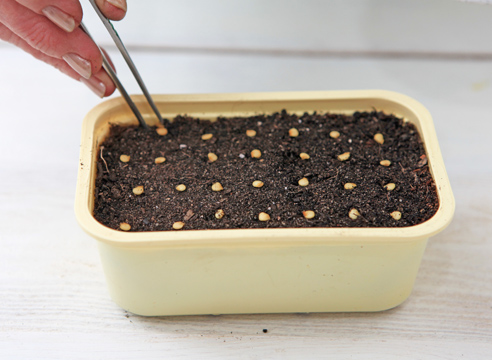
The greater this distance, the longer you can not plant seedlings. Too close sowing will not allow plants to fully develop.Different varieties need to be sown in different containers or separated and marked with some marks so as not to confuse.
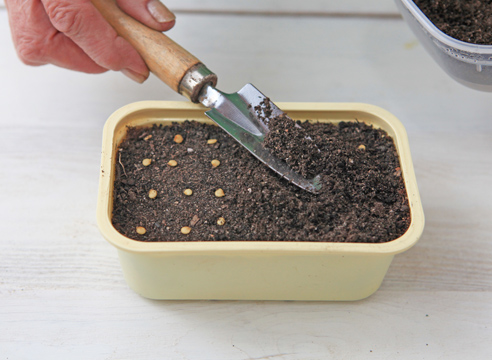
Carefully water or irrigate the crops from the sprayer, otherwise the seeds, not yet fixed in the soil, may emerge, ruining the planting pattern. To prevent moisture from evaporating quickly, the tray should be wrapped in film or covered with glass, simulating a greenhouse. The cover is removed for ventilation for several minutes and completely removed when the seeds germinate.
If sowing is done immediately in separate cups, then you need to put two seeds in each. Then the algorithm is the same as with the box: sprinkle, pour, cover, ventilate. Only when the seedlings have grown, do you need to leave in the cup one, stronger plant. Some farmers prefer this method, since it eliminates damage to still weak seedlings during planting and saves time.
Crop care in the apartment
Of course, it’s easy and pleasant to grow good seedlings in a specially equipped greenhouse with lighting, humidification and temperature control, but not everyone has this opportunity. The realities of a city apartment are much more modest, but with certain knowledge and manipulations, successful seedlings will work out.
Temperature mode
At different stages of seedling development, temperature requirements vary. If the crops themselves require heat 24-26 degrees, then already at the stage of emergence of seedlings it must be significantly reduced - degrees by 7-10. How to achieve this on a regular apartment window sill during the heating season? After all, the operation of the batteries is quite local: it’s hot next to it, and the window already feels cold.
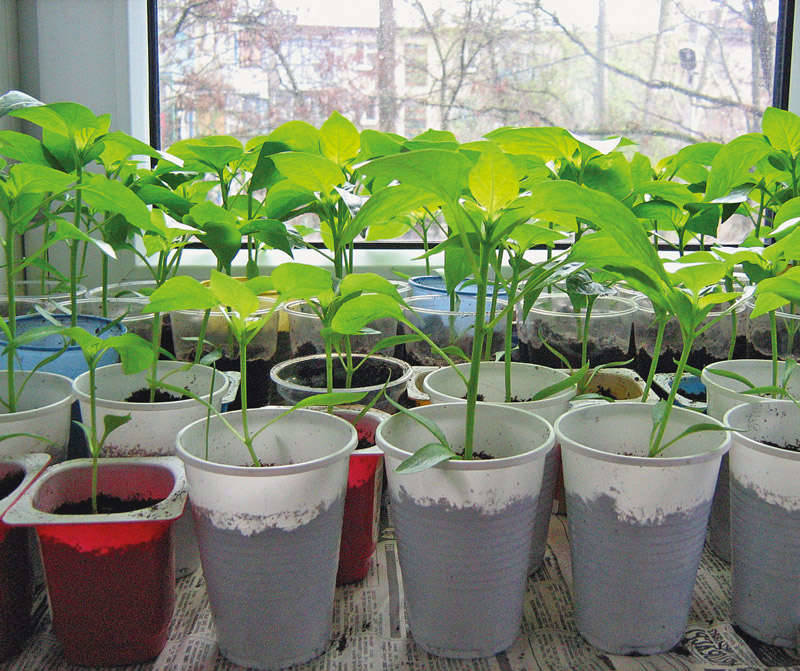
Hatching plants rearrange to light and cool air - just closer to the window. At the same time, we leave the barriers. They should be removed when the seedlings will need warming up to 20-22 degrees. Then on the window with the batteries turned on there will be an optimal balance of temperature and light.
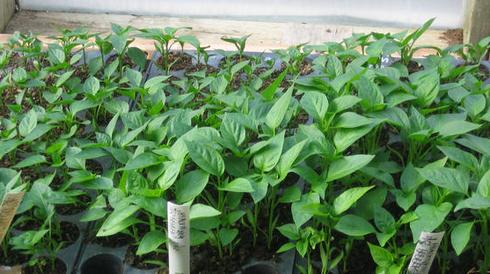 You may be interested in:
You may be interested in:Lighting
Boxes with crops before germination do not need special light, so that they are just kept warm for now. But as soon as the shoots appeared - the transparent cover is removed, and the trays are rearranged to the window. In some cases, for example, for varieties of pepper with a long growing season, and therefore sown in February, ordinary daylight may not be enough. And this is fraught with weakening seedlings on the windowsill, pulling it up. In this case, the stem itself will be thin, weak. In this situation, the best solution would be additional illumination with a phytolamp.
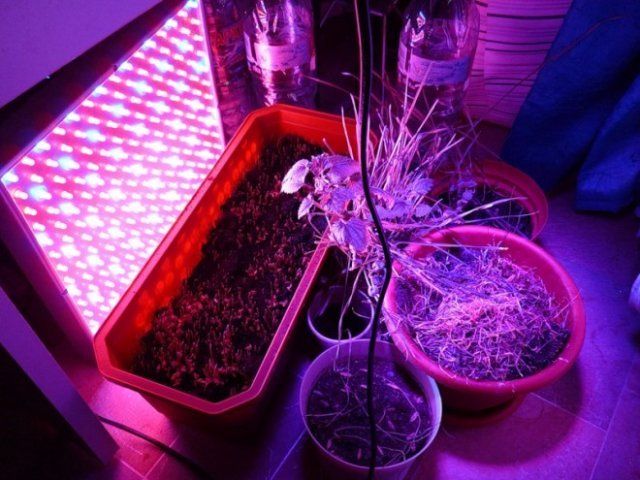
If the purchase of such a lighting device for some reason is not possible, you need to support the seedlings with stimulation, which slightly compensates for poor lighting. With the approaching time of planting on the beds of sunny days it becomes longer, and there is a risk of burns of pepper leaves. Therefore, the southern windows, where there are direct rays, need to be covered by making a curtain or a screen of paper, fabric.
Watering
Often improper watering can spoil all the work of growing pepper seedlings. Therefore, you need to remember the main points:
- water is required warm, even up to 30 degrees, pepper is afraid of hypothermia, especially at the seedling stage;
- water quality characteristic: it should not be from a tap, but at least distant, but better from a filter or a well so that there is definitely no chlorine there;
- dishes for seedlings must have good drainage holes so that they do not become clogged with soil and freely pass excess water, otherwise the pepper roots will be in the earthen liquid and may “suffocate”, although this may not be visible from above;
- based on the previous paragraph, before watering, be sure to check the pan for water in order to understand whether it is necessary to water.
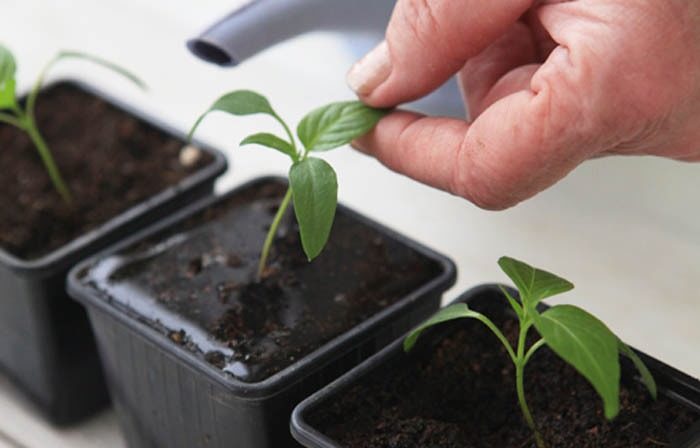
If we talk about the frequency of irrigation, first you need to do this 4-5 times a week in small portions, then the procedure is reduced to 2-3 times, and when 3 full leaves have grown, watering is carried out once a week.
Top dressing and loosening the soil
Pepper - this is just the culture that really needs good nutrition, especially if it grows on the windowsill. There are drugs that support the plant in case of insufficient lighting, temperature fluctuations, help to withstand deviations from favorable living conditions. For example, Baikal-EM, Mikosan, Ecoberin, Healthy Garden.
For intensive growth, you can make complex fertilizers. Be sure to follow the dosage instructions and fertilize seedlings only after watering or diluting the product with water for irrigation.
Good soil friability is characterized by large air spaces in the soil, which are necessary for the roots. Such soil will not go awry over time. Therefore, properly prepared soil does not need to be loosened, especially since deep intervention can damage the roots. Allowed only a slight stirring of the upper layer, if it took the crust due to watering.
Ventilation and hardening
Over time, when the seedlings have grown, you need to monitor the good penetration of air between the stems, especially if they are sown closely. But this does not mean that the wind should blow on them - drafts for pepper are dangerous. Just a well-ventilated room will do, and during the ventilation process itself, the seedlings need to be removed.
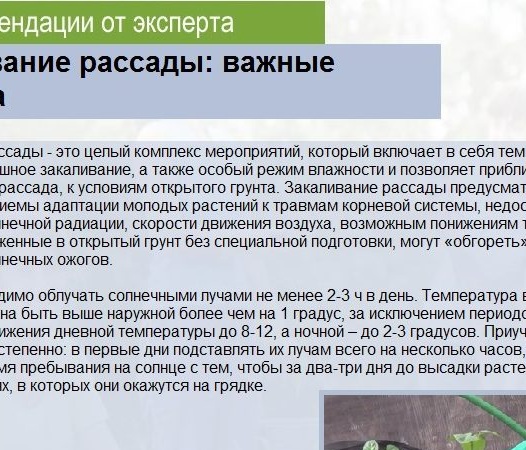
The hardening of pepper begins closer to the time of its landing on the beds - in about 2-3 weeks. At first they simply leave the window open for several hours, then they take out the box to a cooler room, for example, to the balcony. Every day, time is increasing. After a week or two, you can begin to leave seedlings on the balcony for the night to accustom to the difference in day and night temperatures. So plants are prepared for life in the open air.
Pick
Pepper picking is a very delicate and traumatic activity for sprouts and roots. Many avoid it by sowing seeds immediately in separate containers. But if for some reason your seedlings have grown precisely in a common box, then it is necessary to transplant it into a more spacious area. Otherwise, it will stop growing, expecting an improvement in its “living conditions”. Seedlings will dictate the time of the pick: they should have 2 pairs of real leaves.
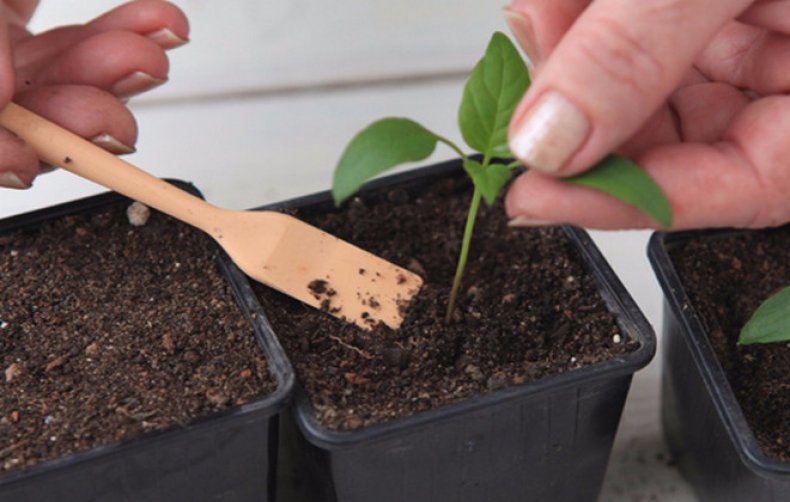
The tray with seedlings should be watered and allowed to drain well. Then the plant is held by the leaves (do not touch the stem, it is fragile, it can easily break) and dig it out with a special spatula or spoon, capturing a good lump of earth around the root. Placed in the prepared hole of a new box, trying not to shake the soil, sprinkled with fresh soil and gently watered. A root can be added to the water, which will alleviate stress and help recover.
On the first day or two, transplanted peppers should be held not on the window, but in the back of the room, a little shaded - for soft adaptation. Then we put them in a permanent place.
Common Growing Questions
Pepper is a rather demanding and capricious plant for beginners, so a lot of questions arise during the growing process:
Any plant can be capricious in inappropriate conditions, especially if it comes from an area with a different climate. But knowing the features of his life, it is quite possible to bring apartment conditions closer to favorable. All this fully applies to sweet pepper, whose seedlings on the windowsill, with proper care, grow strong, healthy and give a generous harvest.




 Calorie pepper stuffed with meat and rice - BZHU per 100 grams
Calorie pepper stuffed with meat and rice - BZHU per 100 grams Gorky pepper - the best varieties for open ground
Gorky pepper - the best varieties for open ground Hot pepper seeds - the best varieties for open ground and reviews
Hot pepper seeds - the best varieties for open ground and reviews Capsicum tincture for hair - how to use and reviews
Capsicum tincture for hair - how to use and reviews